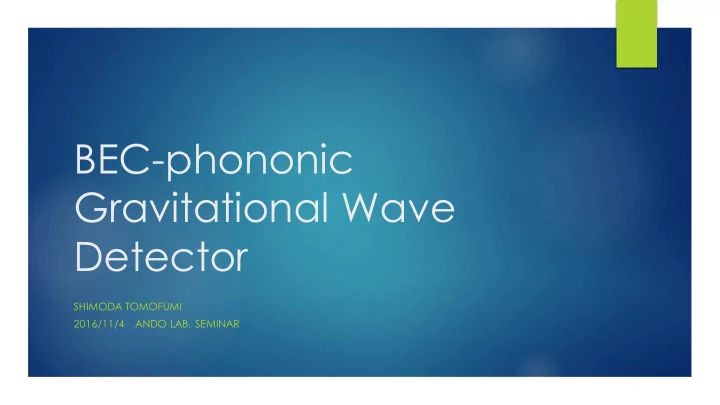

BEC-phononic Gravitational Wave Detector SHIMODA TOMOFUMI 2016/11/4 ANDO LAB. SEMINAR
Paper u “Phonon creation by gravitational waves” (C. Sabin et. al., 2014)
Abstract u A new type GW detector using a Bose-Einstein condensate was proposed u As a consequence of relativistic quantum field theory, phonons are excited by GWs in a BEC trapped in a box-like potential(cavity)
Sketch of setup u BEC in a cavity u phonons are excited by GWs u measure the final state and estimate the GW amplitude
BEC phononic field u The phononic field of BEC obeys a massless Klein-Gordon equation: here, d’Alembertian operator □ is : : Effective spacetime metric
Solution u The solution of Klein-Gordon equation(in flat spacetime) L(rigid) , , : annihilation&creation operator
Particle creation by spacetime distorsion u effects of spacetime distorsion : (Bogoliubov transformation) u the coefficient β mn is associated to particle(phonon) creation :
Effect of gravitational waves u the effect of sinusoidal GW : (m ≠ n) resonate at Ω = ω m + ω n u at resonance( Ω = ω m + ω n ), after enough long duration( ωt>>1 ), phonon creation associated with ε, t, ω m
Similarity to dynamical Casimir effect u effect of GWs coincides with those of a cavity with sinusoidally varying length in flat spacetime u similar to dynamical Cassimir efect photon u a cavity with moving walls creates photon
Compare with an optical cavity GW u the same effect appears in an (~10 4 Hz) optical cavity but at high frequency(~PHz) phonon GW (~10 14 Hz) ~10mm/s photon
Estimation error u Cramer-Rao bound (quantum measurement limit): ε : GW amplitude M : number of probes (~10 14 ) H : Quantum Fisher Information quantum Fisher Information H ε r : two-mode squeezing parameter between mode m,n
Optimal bound of the strain sensitivity(1) Δε ∝ 1/ √ mn sensitivity ~ 10 -26 / √ Hz (10 4 -10 5 Hz) u mode dependence Sensitivity m=1, n=2 u L=1 µ m m=1, n=6 u c s =10mm/s ? u M=10 14 ? m=10, n=11 (= 10 6 atoms × 5Hz repetetion × 1year ) u r=10 (“seem in principle achievable”) measurement time
Optimal bound of the strain sensitivity(2) Δε ∝ e -2r u squeezing dependence r=2 u L=1 µ m, u c s =10mm/s r=3 u M=10 14 r=4 u (m,n)=(10,11)
Δε / √Ω ?? u A sensitivity to continuous GWs (h 0 sin ω t): √ S h [/rtHz] Karl Watte, Phys. Rev. D 85,042003(2012) in our familiar sensitivity, √ S h ~ 10 -23 / √ Hz ?
Noise sources in phonon creation u thermal phonon excitation u negligible at achievable temperature @10nK (normal) : N phonon = 10 -31 ⇔ N phonon ( ε=10 -26 , t=1000s ) ~ 10 -36 @0.5nK (best *) : N phonon = 10 -625 (* A. E. Leanhardt et. al., 2003 / ※ achieved for 2,500 atoms)
How to measure phonons? u Measure the momentum of atoms u release the condensate trapping potential u each phonon state is mapped into the state of an atom u measurement with position-sensitive single-atom detector u Non-destructive method u using atomic quantum dots interacting with the BEC * * C. Sabin et. al., Sci. Rep. 4, 6436 (2014)
Sensitivity curve (???) u detailed information about this plot was not aLIGO described in the paper Einstein Telescope New type
Summary u The effect based on the relativistic quantum field theory was calculated u Spacetime distorsions of GWs can create phonons in a BEC u There are resonances at Ω = ω m + ω n ( Ω :GW freq. / ω n :mode freq.) u At resonance, sensitivity Δε / √Ω ~10 -26 / √ Hz is assumed to be achieved (?) u ( In our familiar sensitivity, √ S h ~10 -23 / √ Hz ? ) u Concrete configuration remains to be considered
Recommend
More recommend